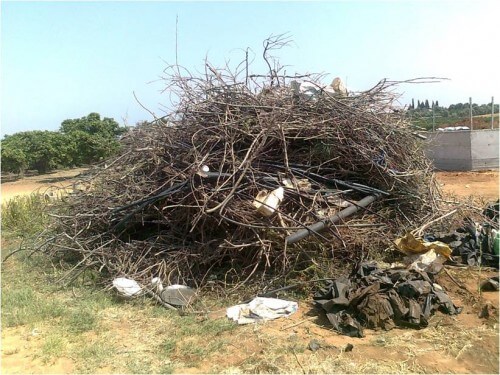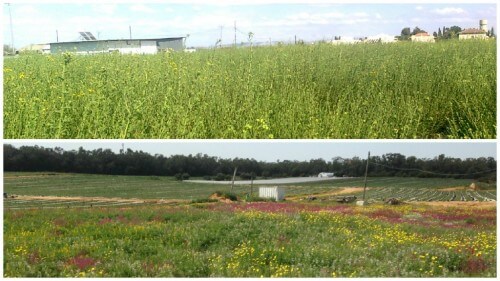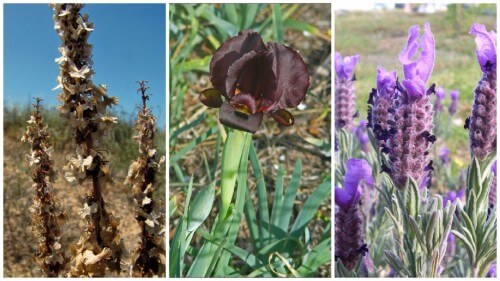A first-of-its-kind ecological restoration project in Israel transforms the edges of agricultural fields in the regional councils into flourishing natural areas. The biggest beneficiaries: the environment, the residents and the farmers themselves. The scientific research will be presented at the annual conference for science and the environment
Yoni Weitz, Angle - news agency for science and the environment

Until recently, the edge of the fields in the Lev Hasharon Regional Council was its neglected backyard. The edges of the orchards were areas where agricultural waste was dumped, and invasive species of plants grew densely there. The situation in the heart of the Sharon reflects in a small way the situation in the entire coastal plain: about 60 percent of the council's area is agricultural space, about 30 percent is built-up area and less than five percent remain as open and natural areas, preserving the past landscapes of the Sharon.
Recently, due to The first ecological restoration project of its kind in Israel - "Agriculture supports the environment", the place is changing its face and its function. In many plots between the fields, agricultural waste was cleared and invasive species were displaced. The farmers stopped spraying herbicides between the rows of trees and sowed native wild plants. The results were not long in coming: less than a year after the restoration, a large variety of species responded to the new-old habitats and returned to them. Now, the rehabilitated plots between the fields are closer in their biological diversity to the natural areas, and the farmers will be able to benefit from the improvement of the pollination process and the presence of natural enemies of the pests in the fields.
In the 43rd Annual Conference on Science and the Environment,, which will be held this year on October 14-12 at the Hebrew University, Gideon Lerman, a planning expert, will present the guide to planning and managing open spaces. This is the first planning tool of its kind in Israel that was developed in the pilot phase for the Lev Hasharon Regional Council. According to the planning guide, the open spaces connect the community and the countryside. From an applied point of view, the guide combines the involvement of government bodies, regional councils, farmers and even the residents in diverse issues and presents tools related to the interrelationship between agriculture and the environment and the place of the residents of the council in activities to preserve the environment.
Change starts from the bottom
The ecological restoration project began three years ago as an initiative of Dr. Ofer Steinitz from the Ministry of Agriculture, in collaboration with the Open Areas Division of the Ministry of Environmental Protection, the Regional Council, the Center of Regional Councils and local farmers. The understanding at the basis of the initiative was that the key to environmental conservation is not only the promotion of environmental policy, but the cooperation with the council, residents and farmers. The regional councils control about 85 percent of the open spaces in Israel, and their maintenance and development are their responsibility.
"The rural area and the regional councils in Israel are currently undergoing a significant change, there is more awareness of the environment and its health and its connection to agriculture", explains Uriel Ben Haim, head of the field of agriculture, sustainability and environment at the center of the regional councils. "The fabric of the territories consists of an urban, agricultural and natural environment. The goal of this project is to create a balance between the two systems and parties for the common good - agriculture supports the environment, and the environment supports agriculture."
Twice a year, researchers go out to examine how the restoration affects the biological diversity and the reaction of the different animals to the treatment in the field. Dr. Itai Ranan and the staff of the Entomological Laboratory for Ecological Monitoring from Tel Aviv University compare the richness of insect species, mainly beetles and ants, between the restored areas and the edges of fields that have not been restored and nearby natural stream channels. Species richness and the presence of ecologically important species, such as predatory species that are responsible for reducing pests, indicate the health of the ecosystem and are a tool for evaluating the restoration process.
Only less than a year after the restoration, Ranan discovered surprising and positive findings: the restored plots between the agricultural fields are approaching the natural areas in terms of biological diversity. These results are extremely encouraging to Aviv Avisher, an ecologist who manages the project on behalf of the regional council, and Dotan Rotem, an open areas ecologist of the Nature and Parks Authority. "The open spaces in the heart of the Sharon are limited in size. With the exception of the Aloni Kadima reserve and the Kadima forest (planted eucalyptus forest, YO), there are no open spaces in the entire regional council," says Avisher. "The best choice is the lack of choice, so we decided to take up the gauntlet. In the current situation, in a country as dense as ours, we do not have the privilege of losing open spaces, and the importance of these spaces is enormous."

Nesting boxes for breathing
As part of the restoration project, first all invasive species such as the sand plover, common cuckoo and the masking method were uprooted. At the same time, local wild plants were sown, some of which are in danger of extinction, such as the crimson iris, the great lavender, the gada kifa, the aeroon and more. The result is that in the area of Moshav Ein Sharid, for example, the edges of fields that were cleared of the sand avalanche turned a year later into an area with a rich variety of plants. Then came a variety of animals such as beetles, ants, bees, reptiles and even hedgehogs.
Alongside the Lev Hasharon Council, the environmental project is also implemented in the Emek Hefer Regional Council and the Beit Nettofa Valley local authority, in cooperation with the Sakhnin Cities Association for Environmental Quality. The various initiatives and ecological restoration activities in each region were adapted to its unique local characteristics. The restoration process in Emek Hafer, for example, focused on expanding the margins of Nahal Alexander, which functions as a central ecological corridor, expanding habitats, planting trees and adding native species.
In the villages of Beit Netufa Valley, where agriculture is highly diversified and of a traditional nature, a more complex course of action was required, which included first of all gaining the farmers' trust by improving the property tax conditions. A social activity was also conducted that promotes agriculture with traditional aspects of the residents of the area, the use of pesticides was reduced and a transition to biological pesticides began. For this purpose, nesting boxes were placed for the ants, which serve as a natural exterminator for the Nevarni population. Along with these, fences that limit the movement of animals were replaced and a reduction was made in the cultivation of the land.

increase mutual benefit
what is the next step? Ecological restoration and preservation of open spaces is a relatively new concept, and is not a one-time operation, but a process that requires years of professional monitoring and guidance. As part of the project, monitoring of the rehabilitation took place only in the Lev Hasharon Regional Council, and that too only for a few years. "Maintaining the restored area will require minimal maintenance, and thus lies the key to its long-term success," says Avisher.
Another challenge is the training of farmers. According to Ben Haim, there is a significant lack of guidance and support for farmers in the environmental field. The scientific knowledge collected requires analysis and dissemination among the councils and farmers, and a situation has arisen in which many of them turn to private consulting and support bodies. A large part of the funding also falls on the shoulders of the regional councils and the residents themselves, and there is a need for greater involvement on the part of the government bodies entrusted with the field.
Dr. Anat Levingart, Director of the Agro-Ecology Division at the Ministry of Agriculture and Dr. Tzafir Greenhut, Director of the Field at the Farmer Training Service, are aware of this lack. According to them, the existing knowledge gaps are a significant challenge in changing the perception. The project is in the process of development, and not enough is known about the application of different methods or the mutual influence between the environment and agriculture. There are estimates of the potential benefits for farmers through ecosystem services. An increase in biodiversity may contribute to biological control by restoring natural enemies to pests, along with improving the pollination process. One of the goals in the coming years is to continue to examine the benefits of the environment for agriculture.
Along with the differences of opinion, the various partners in the project agree that the change that is taking place now is welcome. There has been a change in the understanding of the interrelationships between agriculture and the environment, from systems with "opposing" interests to a concept where mutual benefit is produced: agriculture supports the environment and the environment supports agriculture. The project's ambitions in the coming years are to promote the knowledge of the mutual benefits between the farmer and the environment and to implement an approach that looks at the space, and not only at the limited area of the agricultural plot, and this with the participation of the local population.
The full study will be presented at the annual conference of the Israeli Society for Ecology and Environmental Sciences, October 14-12, 2015, Hebrew University - Edmond Y. Safra Campus, Givat Ram, Jerusalem

7 תגובות
This state is state in English. When you want to be precise, it is sometimes difficult to find a suitable word. I also don't like it when language is disrupted, but in a professional, business, medical, legal context sometimes accuracy is better than purity of language.
The language should serve the speakers, as a tool for transmitting information. In my work I use the term MRA, which stands for Magnetic Resonance Angiography. Do you really think it is necessary to look for a Hebrew translation for this? Who will it benefit?
I agree that in everyday language one should use a Hebrew word - if there is one and if it is familiar enough. But again, language should serve us, not the other way around.
Again the project is blessed... the language?
To "the whole world" it is necessary to speak in a language that will be understood
In Israel they speak and write Hebrew and when there are adequate concepts
Using the language of "the whole world" turns Hebrew into a sloppy mess.
– Project = in Hebrew project,
Whoever writes "project" in Hebrew goes on to write "situation" instead of situation,
"Information" instead of information and so on...
Then he continues down to the plural according to Hebrew laws:
"Projects", "Information", "Situations", etc.
And if it (gentlemen) isn't an idle joke
can we come please
Asaf
I think like Judah. I don't think a project is equal to a project. A project seems more like an initiative to me. Perhaps there is a more appropriate word in Hebrew than venture - I would love to learn. And maybe in this case - "enterprise" is more appropriate...
Lips Lips Lips Maybe because I was sitting on the couch when I responded?
To assemble
I have nothing against the word project, but with the whole world it means project, why wouldn't we also use this word, after all, Hebrew has always added words from other sources such as Aramaic, Greek, Arabic and more.
This is the essence of a living language and there is no reason to impoverish a language (Hebrew) from its foreign words
Please respond gently
Thanks
Yehuda
Lovely project! Well done!
Good to know it exists. I wish it would spread all over the country.
A venture (not a "project") is welcome.